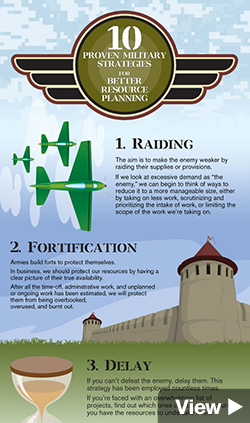
10 Historically Proven Military Strategies that You Can Apply in Your Organization for Optimizing Resources in Product Development
“From Sun Tzu’s 13 principles to Napoleon’s 115 maxims, to the countless other [military] strategies, there are hidden gems of resource management advice that are as relevant today as they were back then.”
After reading this statement in Jerry Manas’ most recent blog, I was excited that he boiled those many strategies down to just 10 for quicker consumption and easier application.
According to 3rd Product Portfolio Management Benchmark Study, nearly 70% of organizations reported “too many projects for their resources” as their top pain point. As the need for some tested and proven resource capacity strategies is clearly in order, Jerry’s words of wisdom, previously posted in Portfolio Perspectives, is spot-on for product development. It offers food for thought about how to optimize resources and I am happy to share it here on The Product Pulse.
Optimizing Your Resources: Learn from the Military
Written by Jerry Manas
 Now more than ever, organizations are asked to do more with less. Pressures mount, competition is building, and there seems to never be enough resources to tackle what needs to be done. Then, when resources are finally allocated to strategic work, the work ends up getting delayed because the people are pulled off on emergencies, managers’ pet projects, and other interruptions.
Now more than ever, organizations are asked to do more with less. Pressures mount, competition is building, and there seems to never be enough resources to tackle what needs to be done. Then, when resources are finally allocated to strategic work, the work ends up getting delayed because the people are pulled off on emergencies, managers’ pet projects, and other interruptions.
The industrial age only took root in the 19th century, and the formal organizational structures we know and love didn’t begin until the 20th century. And resource management hasn’t evolved much since then except for matrix reporting and project-based work, which are fairly recent concepts.
But there is a place we can turn to for advice. Military strategy has been around for thousands of years, at least as far back as Sun Tzu (500 BC), and through the ages of Alexander the Great, Julius Caesar, Hannibal, Napoleon, and on to the present day ‒‒ each commander learning from and building upon the principles that came before.
Many of these principles deal with the effective use of limited resources. Business leaders can look to these principles to solve what is arguably their #1 problem: resource constraints.
From Sun Tzu’s 13 principles to Napoleon’s 115 maxims, to the countless other strategies, there are hidden gems of resource management advice that is as relevant today as they were back then.
“There are not more than five musical notes, yet the combinations of these five give rise to more melodies than can ever be heard.
There are not more than five primary colors (blue, yellow, red, white, and black), yet in combination they produce more hues than can ever been seen.
There are not more than five cardinal tastes (sour, acrid, salt, sweet, bitter), yet combinations of them yield more flavors than can ever be tasted.”
It is the same with strategies and tactics; a select few principles can be used in countless combinations and variations.
Napoleon knew this all too well and is often cited as the greatest military strategist in history, despite his notable losses at Waterloo and Russia. His principles gave birth to many of today’s most commonly used military strategies.
There are countless other military principles that apply to resource management as well. In looking through them, and in the spirit of Sun Tzu’s simplicity, I’ve narrowed thousands of years of principles and maxims down to what I feel are the ten core strategies directly applicable to resource management that can be used in a multitude of combinations. From “Economy of Force” to “Concentration of Force” to “Divide and Conquer,” these strategies, when understood correctly, are powerful ways to optimize your resources.
Download Jerry’s new white paper, 10 Proven Military Strategies for Better Resource Management: Avoiding Custer’s Last Stand.
We’d love to hear your thoughts. Is your organization struggling with making the most effective use of limited resources across major projects, minor work efforts, and ongoing support and “keep the lights on” work? Once you read the white paper, let us know which strategy(s) you are currently employing, or have decided to try, and which are most useful. Are there other strategies not listed that you’ve used with success?

![Why You Need to Participate in Industry Research About Your Product Development and Innovation Efforts [Interview]](https://blog.planview.com/wp-content/uploads/2018/04/PD-Survey.gif)


